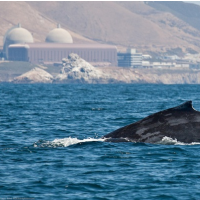Coastal Commission Derails Dangerous Underwater Seismic Mapping near Diablo Canyon
 A humpback whale swims near the Diablo Nuclear Power Plant (photo: Michael L. Baird)
A humpback whale swims near the Diablo Nuclear Power Plant (photo: Michael L. Baird)
The question before the California Coastal Commission this week was whether Pacific Gas and Electric Company (PG&E) needed to blast underwater air cannons near Morro Bay―with a lethal impact on threatened and endangered marine animals―to properly map earthquake fault lines near the Diablo Canyon nuclear power plant in San Luis Obispo.
The answer was not only a resounding 10-0 vote “No,” commission members questioned why the surveys were even necessary.
“These tests are not going to do us any good in terms of protecting the public welfare,” Commissioner Jana Zimmer said at a hearing Thursday, “and the environmental impacts of this project were understated.”
PG&E wanted a permit from the commission to conduct seismic surveys over 130 square miles of ocean by having a boat drag an array of air cannons emitting 250-decibel blasts every 15 seconds around the clock for 17 days. The utility was hoping to assuage fears of earthquake threats to the nuclear plant exacerbated by a fault line discovered in 2008 just 330 yards away, and the 2011 earthquake and tsunami in Japan which devastated that country’s nuclear industry.
PG&E indicated it would compensate commercial fishing interests for any operational losses from the blasts, but environmentalists were concerned because the testing area included two state marine protected areas. Whales, dolphins and sea otters in the area, extremely sensitive to sound, would have been impacted. It was estimated that 2,000 Morro Bay porpoises would have been driven from their foraging grounds.
A PG&E spokesman, noting that the California Public Utilities Commission and the State Lands Commission did not share the commission’s reticence, said it was uncertain what the utility’s next move would be. Some opponents of the sonic blasts maintain that there are effective, less abrasive steps that PG&E can, and should, take to address questions about the plant’s seismic safety. The utility, which strongly defends the plant’s security, has already completed some onshore seismic surveys and is planning some low-key offshore tests.
At least two commissioners at the hearing were inclined to consider a different direction, according to the Los Angeles Times. “It's time to close these plants,” she said. “And it's time to move forward with solar power and alternative energy.”
–Ken Broder
To Learn More:
PG&E Plan to Conduct Underwater Seismic Tests Is Shot Down (by Louis Sahagun, Los Angeles Times)
PG&E's Seismic Testing Plan Rejected (by David Baker, San Francisco Chronicle)
PG&E’s Undersea Sonic Blasts Would Map Quake Faults and Harass Marine Life (by Ken Broder, AllGov California)
- Top Stories
- Controversies
- Where is the Money Going?
- California and the Nation
- Appointments and Resignations
- Unusual News
- Latest News
- California Forbids U.S. Immigration Agents from Pretending to be Police
- California Lawmakers Urged to Strip “Self-Dealing” Tax Board of Its Duties
- Big Oil’s Grip on California
- Santa Cruz Police See Homeland Security Betrayal in Use of Gang Roundup as Cover for Immigration Raid
- Oil Companies Face Deadline to Stop Polluting California Groundwater





